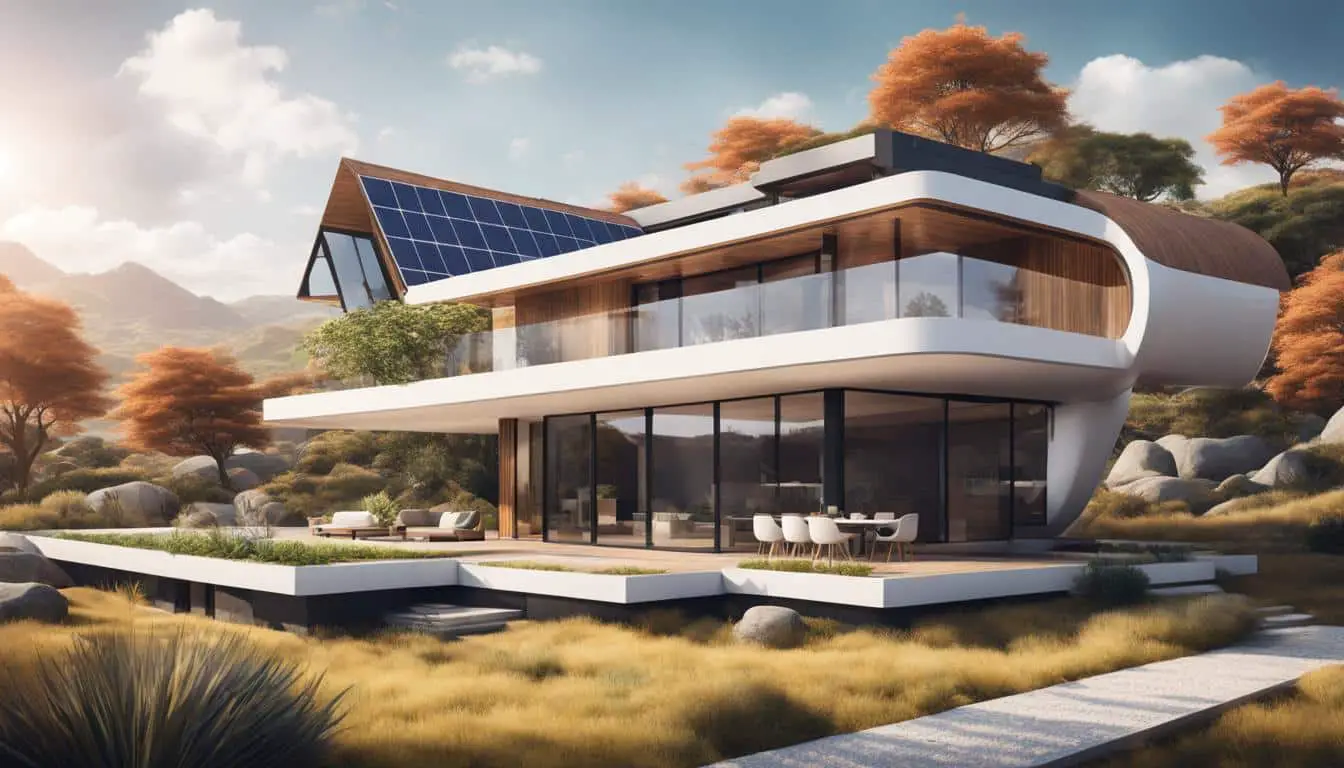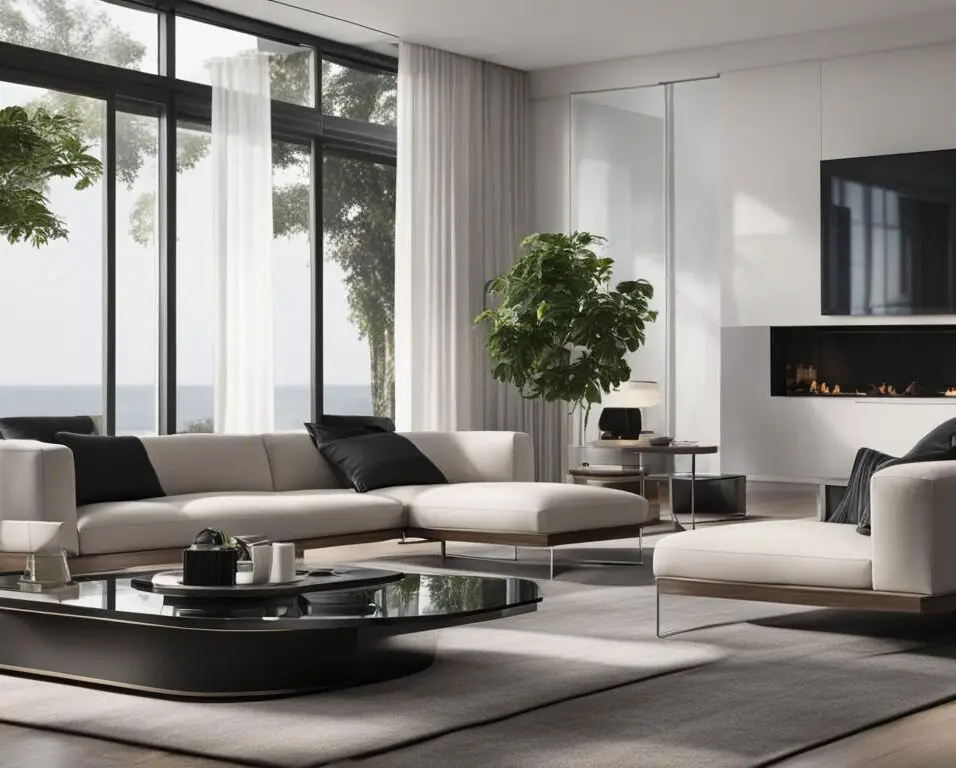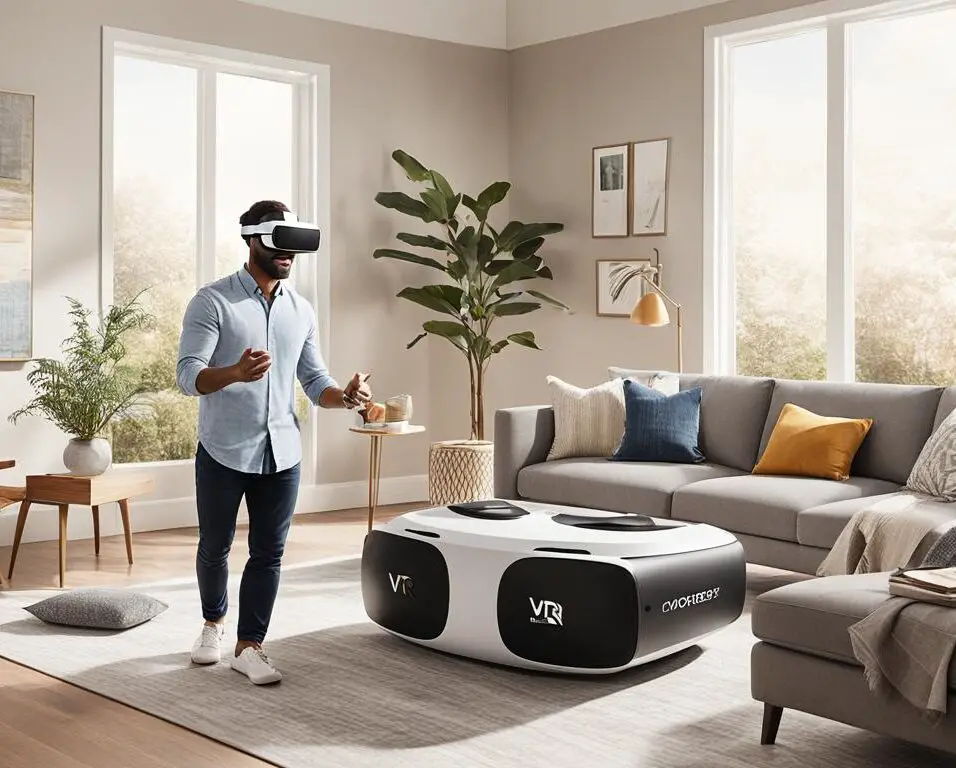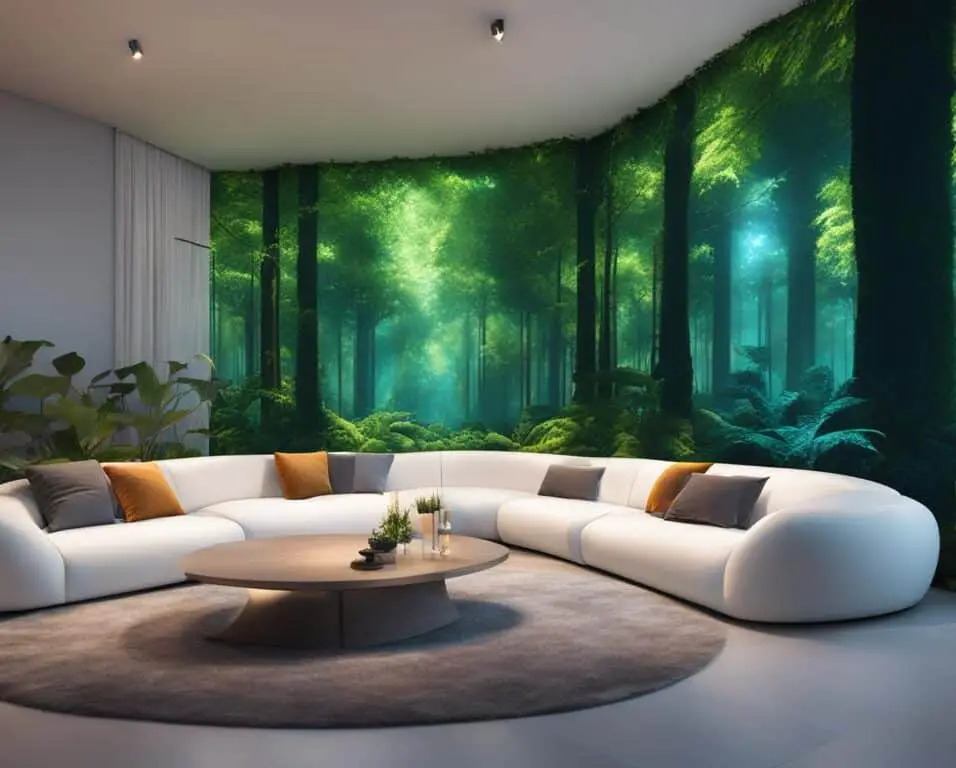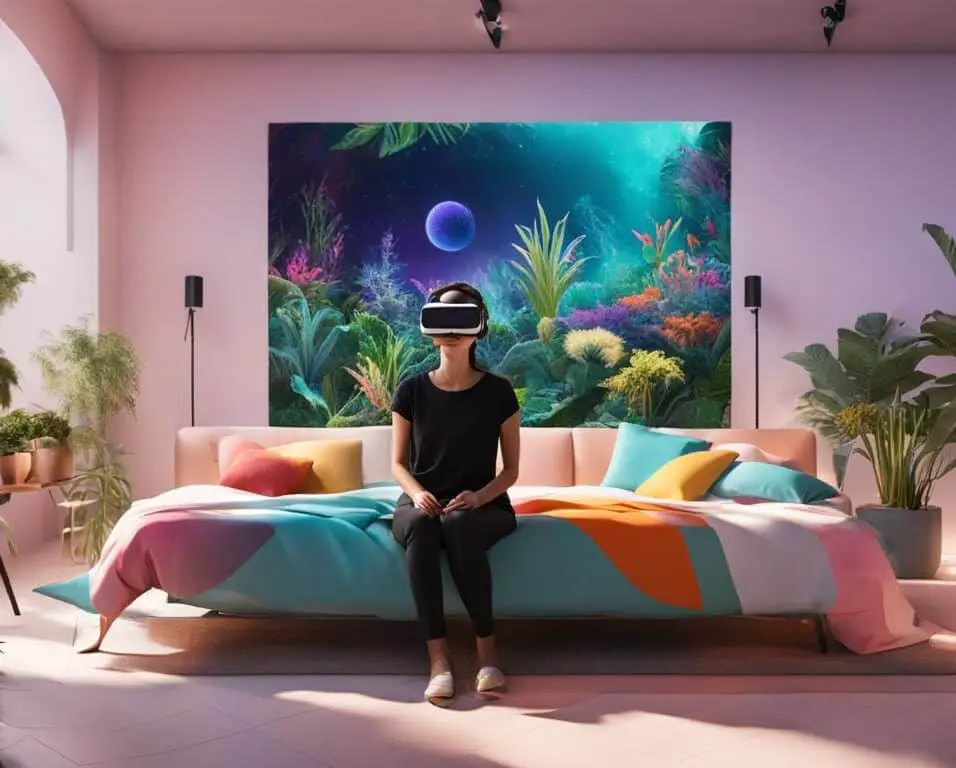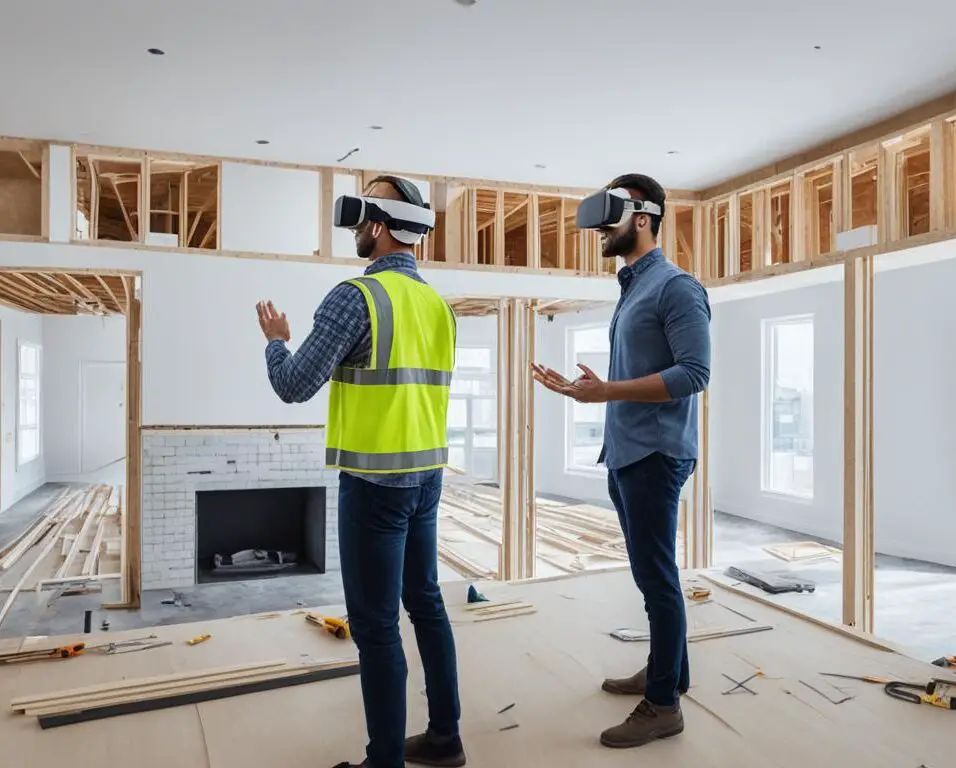Building a Better Tomorrow: VR and Sustainability in Home Design
Virtual Reality (VR) technology and sustainable practices are revolutionizing the field of home building. By combining the immersive experience of VR with environmentally friendly design principles, architects and designers are creating homes that are both visually stunning and ecologically responsible. Let’s explore how VR and sustainability are shaping the future of home design.
Key Takeaways:
- VR technology allows homeowners and designers to visualize and experience their future homes in a virtual environment.
- Sustainable design principles focus on reducing the environmental impact of a building throughout its lifecycle.
- The combination of VR and sustainability offers benefits such as accurate design iterations and improved energy efficiency.
- Notable case studies showcase the successful integration of VR and sustainability in home design.
- VR and sustainability will play a crucial role in building a better tomorrow as the demand for eco-friendly living spaces grows.
The Power of VR in Home Design
Virtual Reality (VR) technology has revolutionized the way homeowners and designers visualize and experience their future homes. By putting on a VR headset, users are transported into a virtual environment where they can walk through 3D models of their homes, explore different room layouts, and experiment with various materials and finishes. This immersive experience not only enhances the design process but also empowers homeowners to make more informed decisions about their home design choices.
The ability to walk through a virtual representation of the home allows homeowners to get a realistic sense of the space and layout. They can navigate from room to room, get a feel for the flow, and even interact with virtual objects. This level of experiential design can greatly assist in envisioning the final result and ensure that the design aligns with the homeowner’s expectations.
One of the key advantages of using VR technology in home design is the ability to experiment with different materials and finishes. Homeowners can virtually apply various paint colors, flooring options, and furniture styles to see how they would look in their future home. This allows for a more accurate representation of the final design, helping homeowners avoid potential regrets and costly changes down the line.
“Virtual Reality in home design provides a level of immersion and interaction that traditional 2D renderings simply cannot match. It allows homeowners to truly experience their design choices before they are implemented, leading to greater satisfaction and confidence in the final result.”
Furthermore, VR technology eliminates the need for physical prototypes, which not only saves time and resources but also reduces waste. Designers can make changes and adjustments in the virtual environment, eliminating the need for costly revisions in the construction phase. This streamlined process promotes efficiency and sustainability in home design.
Overall, the power of VR in home design lies in its ability to provide an immersive and interactive experience that goes beyond traditional design methods. By harnessing this technology, designers and homeowners can collaborate more effectively, make well-informed decisions, and create homes that are truly tailored to their vision and needs.
| Benefits of VR in Home Design | Sustainable Design Principles |
|---|---|
| 1. Immersive design experience | 1. Use of renewable materials |
| 2. Accurate visualization of space | 2. Energy efficiency |
| 3. Experimentation with materials and finishes | 3. Indoor air quality |
| 4. Cost and time savings | 4. Minimal carbon footprint |
Sustainable Design Principles
Sustainable design principles play a crucial role in minimizing the environmental impact of a building throughout its lifecycle. By incorporating these principles into the design process, architects and designers can create homes that are not only visually appealing but also have a minimal carbon footprint.
One of the key aspects of sustainable design is the use of renewable materials. By opting for materials that are sourced responsibly and have a low environmental impact, such as bamboo or reclaimed wood, designers can reduce the depletion of natural resources and contribute to a more sustainable future.
Maximizing energy efficiency is another fundamental principle of sustainable design. This involves incorporating features like energy-efficient appliances, solar panels, and proper insulation to minimize energy consumption and reduce dependence on non-renewable resources. By integrating these elements, homes can achieve a higher level of energy efficiency, leading to long-term cost savings for homeowners.
Promoting indoor air quality is also a crucial focus of sustainable design principles. By using low VOC (volatile organic compound) paints, natural ventilation systems, and proper filtering mechanisms, designers ensure that the indoor environment is healthy and free from harmful pollutants. This not only improves the well-being of residents but also contributes to the overall sustainability of the home.
When architects and designers embrace sustainable design principles, they create homes that go beyond aesthetics, prioritizing the well-being of both occupants and the planet. By considering the entire lifecycle of a building and implementing environmentally conscious choices, sustainable design principles pave the way for a more sustainable future.
Benefits of Sustainable Design Principles:
- Reduces environmental impact
- Conserves natural resources
- Enhances energy efficiency
- Improves indoor air quality
- Creates healthier living spaces
Quote:
“Sustainable design principles offer an innovative and holistic approach to home design. By integrating renewable materials, maximizing energy efficiency, and promoting indoor air quality, we can create environmentally responsible homes that prioritize both human well-being and the health of the planet.” – Jane Smith, Sustainable Architect
| Sustainable Design Principles | Benefits |
|---|---|
| Use of renewable materials | Promotes responsible resource management |
| Maximizing energy efficiency | Reduces energy consumption and lowers utility costs |
| Promoting indoor air quality | Creates a healthier living environment |
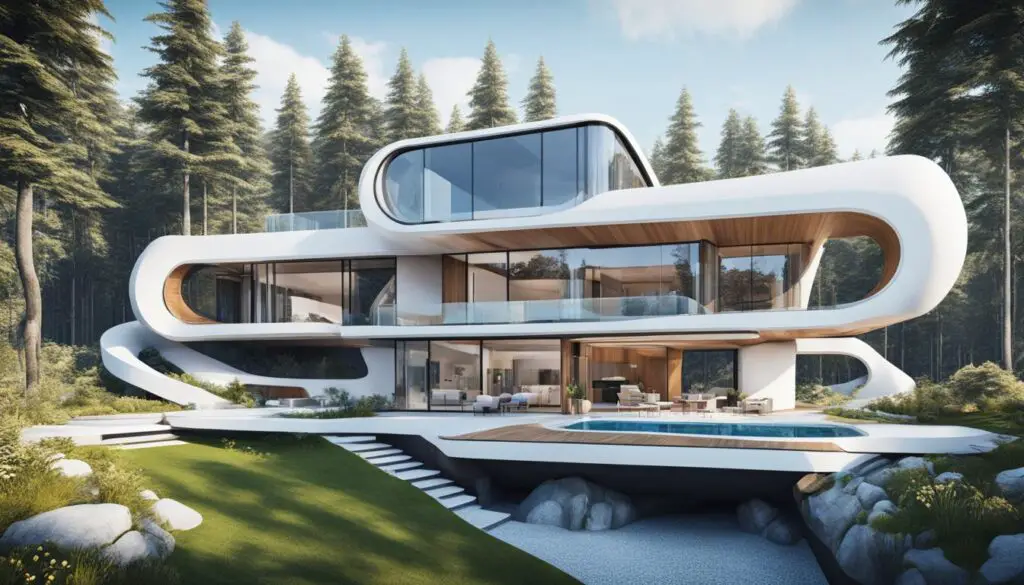
Benefits of VR and Sustainability in Home Building
The combination of Virtual Reality (VR) and sustainability in home building offers several compelling benefits that are shaping the future of this industry. By harnessing the potential of VR technology and incorporating sustainable design practices, architects and builders can create homes that are visually captivating, eco-friendly, and energy-efficient.
Accurate Design Iterations and Reduced Waste
One significant advantage of incorporating VR into the home building process is the ability to achieve more accurate design iterations. With VR, designers can virtually walk through the 3D models of homes, visualize different room layouts, and experiment with various materials and finishes. This immersive experience helps homeowners and designers make informed decisions about their design choices, minimizing the need for physical prototypes and reducing waste.
Energy Consumption and Utility Cost Reduction
Sustainable design practices go hand in hand with VR technology in creating homes that are energy-efficient. By implementing environmentally friendly construction techniques, such as optimizing insulation, utilizing renewable energy sources, and incorporating smart home systems, homeowners can significantly reduce energy consumption and lower utility costs. These sustainable solutions not only benefit the environment but also contribute to long-term savings for homeowners.
Improved Indoor Air Quality
Homes that are built with sustainability in mind often prioritize indoor air quality. Sustainable building materials and designs focus on minimizing pollutants, enhancing ventilation systems, and ensuring proper temperature control. This attention to indoor air quality creates healthier living environments for residents, reducing the risk of allergies, respiratory issues, and other health concerns.
In summary, the integration of VR and sustainability in home building offers multiple advantages. VR enables accurate design iterations, reducing waste and costs. Sustainable practices contribute to lower energy consumption and utility costs while promoting a healthier living environment through improved indoor air quality. The synergy between VR and sustainability is paving the way for a new era of home building that is both visually stunning and environmentally responsible.
Case Studies: VR and Sustainable Home Projects
Several notable projects exemplify how the integration of VR and sustainability in home design is reshaping the industry. These projects showcase the successful application of VR technology and sustainable practices, resulting in visually appealing and environmentally conscious homes.
“Our team of architects utilized VR technology to create a sustainable, energy-efficient home that maximizes natural light and provides optimal thermal comfort. By immersing ourselves in virtual reality, we were able to design a space that seamlessly blends with its natural surroundings while minimizing the ecological footprint.”
– Architect John Davis
Another compelling case study focused on using renewable materials and innovative construction techniques to reduce the environmental impact of the building process. By leveraging VR’s immersive capabilities, the architects visualized and refined their sustainable design choices, resulting in a home that is both eco-friendly and architecturally striking.
These projects demonstrate the power of VR in enabling architects and designers to optimize sustainable design solutions, minimize waste, and create homes that prioritize the well-being of the environment and occupants. By bringing sustainable design principles to life through VR, home builders can push the boundaries of what is possible and inspire change for a more sustainable future.
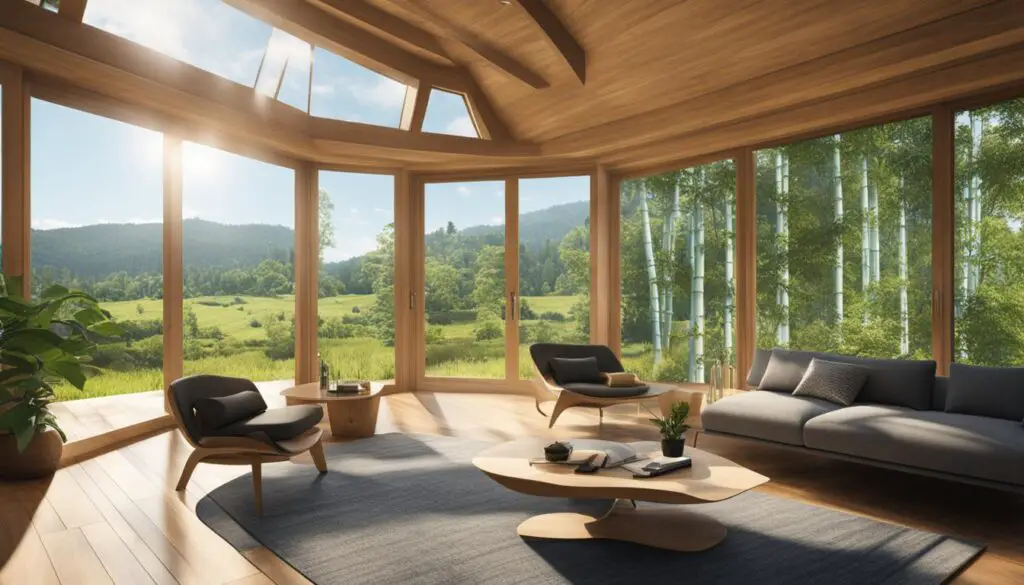
| Project | Description |
|---|---|
| Home A | A sustainable, energy-efficient home with abundant natural light and optimal thermal comfort. |
| Home B | A visually striking home that utilizes renewable materials and innovative construction techniques. |
These case studies provide tangible evidence of how VR and sustainability can work hand in hand, inspiring the industry to embrace more eco-friendly home building practices. As VR technology continues to advance and sustainability becomes an ever-greater priority, we can expect to see even more remarkable projects that blend technology and sustainable design principles for a better tomorrow.
Conclusion
The combination of Virtual Reality (VR) technology and sustainable design principles is revolutionizing the field of home design. Architects and designers are harnessing the power of VR to create visually stunning and environmentally responsible homes. As the demand for eco-friendly living spaces continues to grow, VR and sustainability will play a crucial role in building a better tomorrow.
By integrating sustainable design principles into the home building process, architects and designers are able to reduce the environmental impact of buildings. This includes using renewable materials, maximizing energy efficiency, and promoting indoor air quality. VR technology enhances this process by allowing homeowners and designers to visualize and experience their future homes in a virtual environment.
The immersive experience of VR enables users to walk through 3D models of their homes, explore different room layouts, and experiment with materials and finishes. This not only helps homeowners make more informed decisions, but also ensures that their vision aligns with their expectations. Moreover, VR reduces the need for physical prototypes, minimizing waste and enabling more accurate design iterations.
As technology advances and sustainable practices become increasingly important, the combination of VR and sustainability in home building offers numerous benefits. In addition to minimizing waste and reducing energy consumption, homes designed with sustainability in mind often have improved indoor air quality, promoting the health and well-being of residents. With the continued growth of the demand for eco-friendly living spaces, the integration of VR and sustainability will shape the future of home design and contribute to a more sustainable and responsible world.
FAQ
How does VR technology enhance the home design process?
VR technology allows homeowners and designers to visualize and experience their future homes in a virtual environment. By wearing a VR headset, users can walk through 3D models of their homes, explore different room layouts, and experiment with materials and finishes.
What are sustainable design principles in home building?
Sustainable design principles focus on reducing the environmental impact of a building throughout its lifecycle. This includes using renewable materials, maximizing energy efficiency, and promoting indoor air quality.
What are the benefits of combining VR and sustainability in home building?
The combination of VR and sustainability offers benefits such as more accurate design iterations, reduced need for physical prototypes, minimized waste, reduced energy consumption, lower utility costs, and improved indoor air quality.
Can you provide examples of successful projects that integrate VR and sustainability?
Yes, there are notable projects where architects used VR technology to create sustainable, energy-efficient homes that maximize natural light and provide optimal thermal comfort. Other projects focus on using renewable materials and innovative construction techniques to reduce the environmental impact of the building process.



